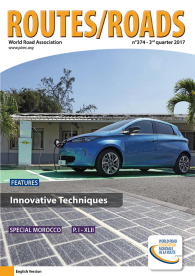Features
Innovative Road-Building Technologies Dedicated to the Innovative Road
The road, as currently perceived in France, was designed and conceptualized during the 20th century in order to accompany the growth of society. This growth, highly correlated with private gasoline-powered vehicles, no longer appears to be sustainable, especially in urban settings, given the extent to which highways have engendered environmental nuisances and pollution as an enticement for urban sprawl. In reality, the presence of the automobile has generated negative externalities. To mitigate these impacts, the vehicles in circulation have gradually improved in terms of both ecological performance and energy consumption, in response to increasingly strict regulations. The road, which until now had only been responsible for producing 5% to 10% of negative environmental externalities, will be absorbing a larger share as the cars in circulation are renewed. Moreover, digital technologies are on the cusp of revolutionizing individual mobility patterns. Tomorrow's fleet of vehicles will be electric, autonomous and shared, meaning that the road will be required to adapt to the needs created by this newfound mobility, against the backdrop of a public financing crisis hindering the road adaptation process. It has also become essential to devote resources towards inventing a framework more favorable for innovation, so as to ensure that the innovative techniques developed at research facilities are being tested more quickly and used in combination, while at the same time laying the groundwork for future innovation.
- Already registered? Login here!
- Are you a new reader? Register here!
Warning! To login, your browser must accept cookies.






